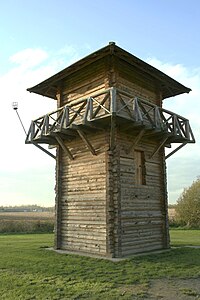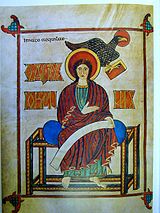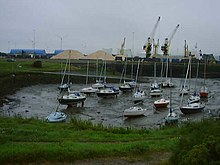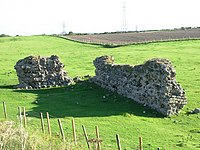Workington
| Workington | |
| Cumberland | |
|---|---|
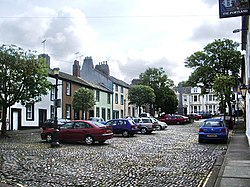 Portland Square | |
| Location | |
| Grid reference: | NX996279 |
| Location: | 54°38’11"N, 3°33’18"W |
| Data | |
| Population: | 24,295 (2001) |
| Post town: | Workington |
| Postcode: | CA14, CA95 |
| Dialling code: | 01900 01946 |
| Local Government | |
| Council: | Cumberland |
| Parliamentary constituency: |
Workington |
Workington is a port town on the west coast of Cumberland standing at the mouth of the River Derwent. Workington is 32 miles southwest of Carlisle, 7 miles west of Cockermouth, and 5 miles southwest of Maryport. An industrial town, Workington and its district have long been a producer of coal, steel and high grade iron ore.
Contents
The name of the town
The name Workington, is from the Old English language. Whether it is from weorc (meaning "work" in all its modern senses) or an individual with a simlar name is unknown. In 1533, John Leland believed that the town derived its name from the River Wyre, but the River Wyre, rising in the hills, enters the Solway at Harrington.[1]
History
Roman Empire to 410 AD
Roman forts, mile-forts and watchtowers were established down the coast of Cumberland to act as coastal defences against barbarian attacks.[2] William Camden's Britannia (late sixteenth century) describes ruins of the coastal defences at Workington, where fort now known as Burrows Walls, was established on the north bank of the mouth of the River Derwent, near present-day Siddick Pond and Northside:
- From thence some thinke there was a wall made to defend the shore in convenient places, for foure miles or there about, by Stilicho the potent commander of the Roman state, what time as the Scots annoyed these coasts out of Ireland. For thus speaketh Britaine of herselfe in Claudian:
St Cuthbert and the Lindisfarne Gospels (c880)
In 875 Vikings invaded the Northumbrian coast and burnt the island monastery of Lindisfarne. Some of the monks fled, carrying with them St Cuthbert's body and a richly decorated copy of the Lindisfarne Gospels. The monks bore the body and the Gospels around Northumbria and around 880 they came down the Derwent to western Cumberland. It is believed that there was a related religious community where St Michael's Church stands today. Tradition says that the box carrying the Gospels were lost overboard as the monks sailed the sea but washed ashore at Whithorn (Wigtownshire).
After seven years' wandering with Cuthbert's body the monks found a resting place at Chester-le-Street and later in Durham. The Lindisfarne Gospels, "The Pinnacle of Anglo-Saxon Art" are now on view in the British Museum in London and Cuthbert's body lies in Durham.[4]
Norsemen
Vikings in time came to Cumberland and settled. A Viking sword possibly frm aburial has been uuncovered in Workington[5] Place-name evidence in Cumberland shows a rich mixture of English, Norse and Brythonic (Old Welsh) influence. At this time too Workington was a border town as Cumberland passed between the English, the Norse, the Kingdom of Strathclyde and Scotland.
Later Middle Ages
Cumberland was annexed to England in 1092 and again a century later. In the wars which beset the island in the Middle Ages, Workington and its neighbours were much prone to conscription of soldiers to fight in the north. King Edward I also conscripted the ships of Workington for his campaigns.
The Curwen family became dominant in Workington and remained so for centuries.
Mary, Queen of Scots
In 1568, Mary, Queen of Scots wrote a letter from Workington Hall to Queen Elizabeth I of England. After the defeat of her forces at the Battle of Langside and disguised as an ordinary woman, Queen Mary,[6] crossed the Solway Firth and landed at Workington. She spent her first night in England as an honoured guest at Workington Hall. On 18 May 1568, Mary was escorted to Carlisle Castle after spending a day at Cockermouth. She was 25 years old.[7]
William Camden's Britannia (1586)
In 1577, William Camden began to write his book Britannia, a county-by-county description of Great Britain and Ireland. He describes Wirkinton:
Derwent, having gathered his waters into one streame, entreth into the Ocean at Wirkinton, a place famous for taking of Salmons, and now the seat of the ancient family of the Curwens Knights, who fetch their descent from Gospatric Earle of Northumberland, and their surname they tooke by covenant and composition from Culwen a family in Galloway, the heire whereof they had married; and heere have they a stately house built Castlelike, and from whom (without offence or vanity be it spoken) my selfe am descended by the mothers side.
He then goes on to describe the coastal defences described in this article in the section on the Romans.
John Christian Curwen (1756-1828)
Workington changed radically both economically and socially, during the period when John Christian was lord of the manor (1783–1828).[8] A Curwen through his mother's side, he stands out as one of the most interesting leaders of Cumberland society of his day.[9] He was Member of Parliament for Carlisle from 1796 to 1812 and from 1816 to 1820, following this with a period as member for Cumberland from 1820 to 1828. He made a national mark in his campaigns for reform of the Corn Laws and Agrarian Laws, and for Roman Catholic emancipation.
Curwen was offered a peerage by both Addington and Castlereagh but he turned them down. His practical interest in agricultural reform can be traced in the proceedings of the Workington Agricultural Society, of which he was founder-president.[10] Cumberland archive records contain reports on Curwen's experimental farm at the Schoose, and on such other items as the estate he purchased between Windermere and Hawkshead, Lancashire, in order to encourage forestry. By planting over 800,000 trees around Lake Windermere he transformed that area of the Lake District. He was also an active supporter of the abolition of slavery and a friend of William Wilberforce, who spent time with John Christian on Belle Isle.
Another interesting project was his introduction of social security and mutual benefit schemes for his farm and colliery workers.[11]
Uppies and Downies
Workington is home to the ball game known as "Uppies and Downies", a traditional version of football, with its origins in Mediæval mob football.[12][13][14][15] Since 2001, the matches have raised over £75,000 for local charities.[16][17][18] An Uppies and Downies ball is made from four pieces of cow leather. It is 21 inches (53 cm) in circumference and weighs about two and a half pounds (1.1 kg). Only three hand-made balls are produced every year and each is dated.[19] Some players from outside Workington take part, especially those from other towns of West Cumberland; Whitehaven and Maryport. As with much of the town's sporting history, some of the best and most accurate records are to be found in the local newspapers, The Evening Star and The West Cumberland Times and Star.
The game has been threatened by proposed developments. The local newspaper reported that Uppies and Downies veterans believe that if the ancient rights of the people of Workington are threatened:
It will take a squad of riot police, with the army in support, if an attempt is made to stop the traditional mass football game being played on The Cloffocks in Workington.
Locals use the words of their celebrated poet, Ethel Fisher MBE, when emphasising the staying power of this tradition:
But ah varra much doot - Thu'll ivver last oot - Uz laang uz t'Uppies un Doonies[20]
Burrow Walls
Burrow Walls is the site of at least one Roman fort and a Norman hall. The first Norman Lords of the manor of Workington lived at Burrow Walls, before moving to the present site south of the river in the 13th century.[21] The site has fallen into neglect and decay, a cause of certain local anguish.
The occupation of the site is believed to have begun some time after King William II (Rufus) moved north and the lands were given to Ketel.[22] An early 12th century manuscript records that "Ketel gives to the monks of St Mary of York the church of... Wirchington with land in Wirchington..."[23][24]}}
References
- ↑ Byers Richard (1998), The History of Workington, An Illustrated History from Earliest Times to AD 1865, Richard Byers Pub. Cockermouth, p22.
- ↑ Byers Richard (1998), The History of Workington, An Illustrated History from Earliest Times to AD 1865, Richard Byers Pub. Cockermouth
- ↑ "cumbeng". Philological.bham.ac.uk. http://www.philological.bham.ac.uk/cambrit/cumbeng.html#cumb1. Retrieved 2009-06-21.
- ↑ "The Pinnacle of Anglo-Saxon Art and The priceless Lindisfarne Gospels". bl.uk. http://www.bl.uk/onlinegallery/ttp/ttpbooks.html. Retrieved 2009-08-19.
- ↑ "The Viking Sword of West Seaton, Workington". workington.wikia.com. http://workington.wikia.com/wiki/The_Viking_Sword_of_West_Seaton,_Workington. Retrieved 2009-08-20.
- ↑ Marilee Mongello. "Mary, Queen of Scots: Biography, Portraits, Primary Sources". Englishhistory.net. http://englishhistory.net/tudor/relative/maryqosbiography.html. Retrieved 2009-06-21.
- ↑ "Timeline of The Life of Mary, Queen of Scots". Marie-stuart.co.uk. http://www.marie-stuart.co.uk/timeline.htm. Retrieved 2009-06-21.
- ↑ "The Curwen Family of Workington hall 1358-1939". nationalarchives.gov.uk. http://www.nationalarchives.gov.uk/a2a/records.aspx?cat=1831-dcu&cid=0#0. Retrieved 2009-08-24.
- ↑ "Extract: The Curwen Family of Workington hall 1358-1939". nationalarchives.gov.uk. http://www.nationalarchives.gov.uk/a2a/records.aspx?cat=1831-dcu&cid=0#0. Retrieved 2009-08-24.
- ↑ "Schoose farm Records". nationalarchives.gov.uk. http://www.nationalarchives.gov.uk/a2a/records.aspx?cat=1831-dcu&cid=8#8. Retrieved 2009-08-24.
- ↑ "Workington and other Friendly Societies". nationalarchives.gov.uk. http://www.nationalarchives.gov.uk/a2a/records.aspx?cat=1831-dcu&cid=34#34. Retrieved 2009-08-24.
- ↑ "The Uppies and Downies of England's Great Traditions". times.co.uk. 2008-02-15. http://www.timesandstar.co.uk/the_uppies_and_downies_of_england_s_great_traditions_1_35420?referrerPath=home/search_results_page_2_1681. Retrieved 2009-08-08.
- ↑ "Football Extraordinary (Timaru Herald, New Zealand, 14 June 1899, Page 4)". paperspast.natlib.govt.nz. http://paperspast.natlib.govt.nz/cgi-bin/paperspast?a=d&d=THD18990614.2.28. Retrieved 2009-10-25.
- ↑ "Uppies and Downies to be immortalised in public art". times.co.uk. 2008-05-09. http://www.timesandstar.co.uk/artist_captures_uppies_and_downies_1_103381?referrerPath=home/search_results_page_2_1681. Retrieved 2009-08-08.
- ↑ Henricks, Thomas S. (1991-07). Disputed pleasures: sport and ... - Google Books. Books.google.co.uk. ISBN 9780313274534. http://books.google.com/?id=91xjXRYPyKYC&pg=PA60&lpg=PA60&dq=mass+ball+game. Retrieved 2009-06-29.
- ↑ Letters, Opinions (2009-08-07). Uppies and Downies raise £7,438 for Macmillan Cancer. Workington: Times and Star.
- ↑ "Uppies and Downies raise £7,000 for RNLI". timesandstar.co.uk. 2008-05-02. http://www.timesandstar.co.uk/uppies_and_downies_raise_7_000_for_rnli_1_98717?referrerPath=home/search_results_page_2_1681. Retrieved 2009-08-08.
- ↑ "Uppies and Downies Worldwide". timesandstar.co.uk. 2006-02-04. http://www.timesandstar.co.uk/news/other/uppies_and_downies_world_wide_1_344557?referrerPath=home/search_results_page_2_1681. Retrieved 2009-08-08.
- ↑ "Workington is home to a tradition known as Uppies and Downies". Uppiesanddownies.info. http://www.uppiesanddownies.info/ball.htm. Retrieved 2009-06-29.
- ↑ Uppies un Doonies, Ethel Fisher MBE (1998), Humorous Tales in Cumbrian Dialect Rhyme, Hills, Workington, p97.
- ↑ Byers Richard (2003), The History of Workington, An Illustrated History from 1866 to 1955, Richard Byers Pub. Cockermouth. p32-33
- ↑ Byers Richard (2003), The History of Workington, An Illustrated History from 1866 to 1955, Richard Byers Pub. Cockermouth. p30
- ↑ "The Evolution of an Anglo-Saxon Place-name". Workington.wikia.com. 2009-07-29. http://workington.wikia.com/wiki/The_Evolution_of_an_Anglo-Saxon_Place-name. Retrieved 2009-08-11.
- ↑ Barron Oswald (1904) - The Curwens of Workington - The Ancestor, A Quarterly Review of County and Family History, Heraldry and Antiquities, No IX
